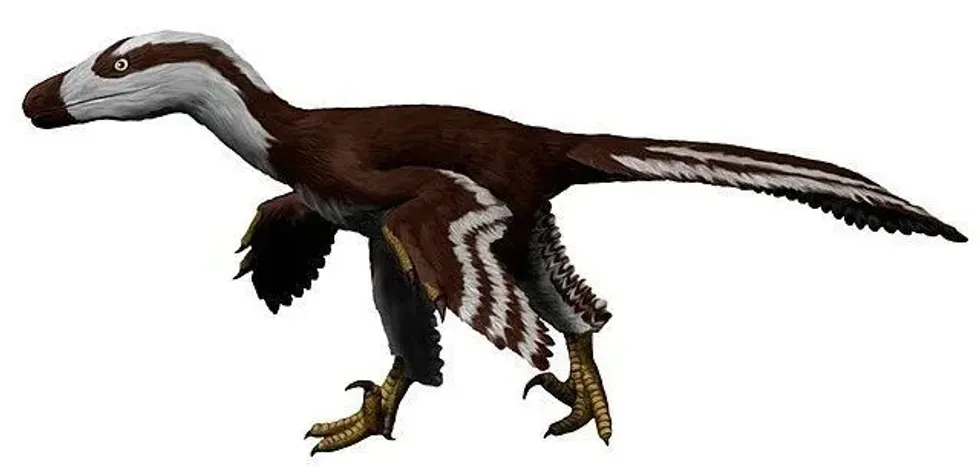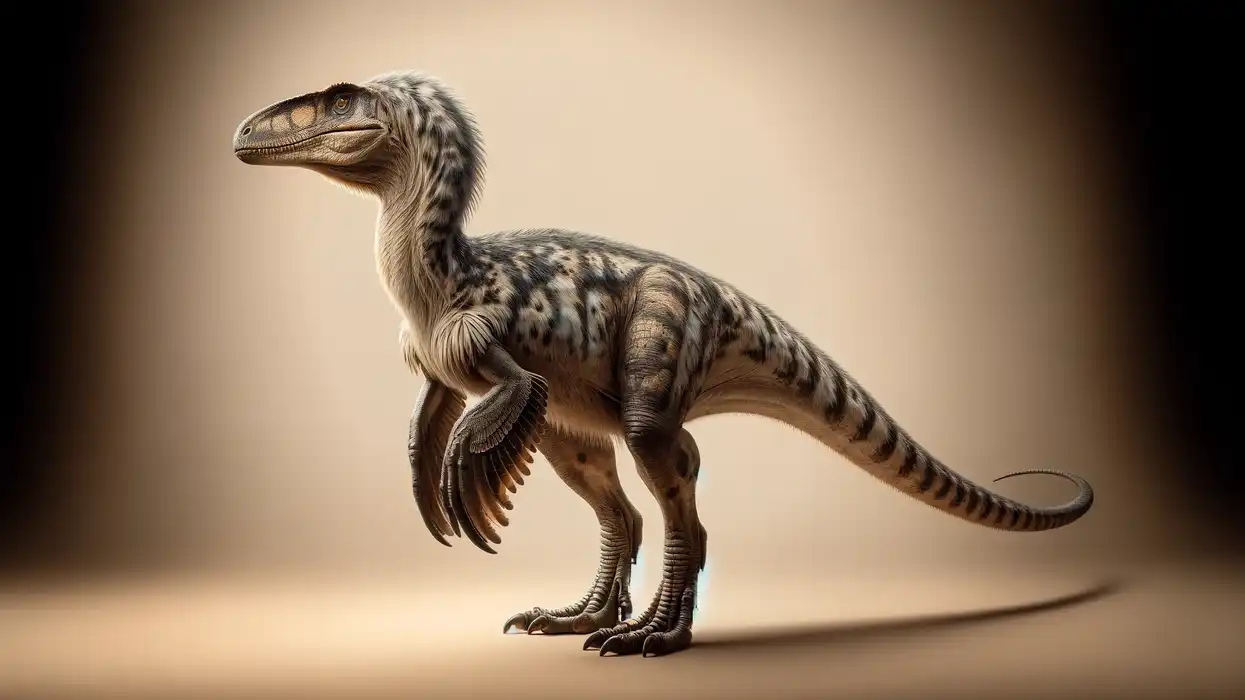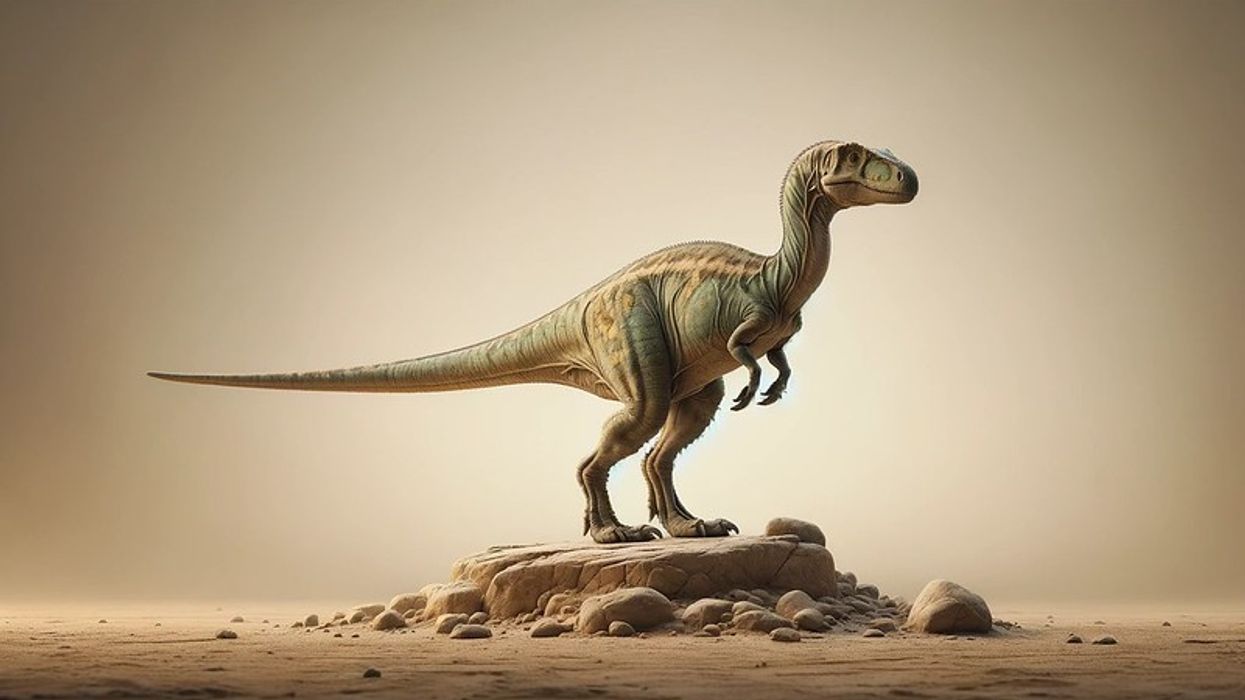The Acheroraptor, belonging to the Hell Creek Formation of the Late Cretaceous of North America in Montana, existed about 66 million years ago, at the same time as the Tyrannosaurus and Triceratops. The genus name of this animal literally translates to 'underworld thief', alluding to its location of discovery.
The name was given by Philip J. Currie, David C. Evans, and Derek W. Larson. The fossil remains of Acheroraptor are incomplete and consist of teeth, right maxilla, and dentary.
The length of the Acheroraptor was about 9.8 ft (3 m). This length is comparable to that of the Deinochyus.
The teeth of this animal were sharp and dagger-like, pointing to its carnivorous nature. Its body was probably covered with feathers, similar to other Dromaeosaurids.
While further research is required to understand all the traits and characteristics displayed by the Acheroraptor, scientists have ascertained that this Dromaeosaurid was one of the last of its kind, marking the diminishing diversity in this group of dinosaurs.
To learn more about Acheroraptor, keep reading! You can also check out Ambopteryx and Parasaurolophus.
Acheroraptor Interesting Facts
How do you pronounce 'Acheroraptor '?
The pronunciation of the name 'Acheroraptor' is 'A-ker-o-rap-tor'.
What type of dinosaur was an Acheroraptor?
Acheroraptor was a Theropod dinosaur, better described as a dromaeosaurid, due to being a member of the Dromaeosauridae family. They are one of the geologically youngest known members of this family.
While Theropod dinosaurs were characterized by three-toed limbs and hollow bones, the Dromaeosaur dinosaurs classified under Theropoda were feathered and carnivorous dinosaurs that established a successful community during the Cretaceous period.
In which geological period did the Acheroraptor roam the Earth?
Acheroraptor roamed the Earth during the Late Cretaceous, corresponding to the Maastrichtian stage. This era occurred 67.2-66 million years ago. It existed at the same time as Tyrannosaurus rex and Triceratops.
When did the Acheroraptor become extinct?
This Theropoda probably went extinct at the end of the Maastrichtian stage, in the Late or Upper Cretaceous period. This is further supported by the fact that the Maastrichtian era was followed by the Cretaceous–Paleogene extinction event, which resulted in the extinction of the dinosaurs, with only the mammals and birds surviving.
Where did an Acheroraptor live?
The upper and lower jaw fossils of this dinosaur were discovered from the Hell Creek Formation in Montana, USA, in North America. Currently, the holotype fossils are stored in the Royal Ontario Museum.
What was an Acheroraptor's habitat?
The Hell Creek Formation, where this North American dinosaur specimen was found, was likely a flat and forested flood plain with streams. This region supported the growth of a number of plants, including angiosperms and different conifers and ferns, along with ginkgo.
Who did an Acheroraptor live with?
Acheroraptor may have lived in packs or formed a community. However, since no aggregated fossil specimens have been recovered, it is difficult to confirm their social behavior and structure.
How long did an Acheroraptor live?
Sufficient data confirming the life span of the Acheroraptor is missing. However, the related Velociraptor lived for 15-20 years. So, this animal may have had a similar lifespan.
How did they reproduce?
The Acheroraptor from the period of the Latest Cretaceous of North America reproduced by laying eggs, making it oviparous. In the case of the related Velociraptor, there were two oviducts in the female, which imparted them with the capability of developing two eggs at a time.
They probably laid their eggs in nests and protected the eggs with their wings. Similar reproductive behavior may have been displayed by this single member of the Acheroraptor genus.
Acheroraptor Fun Facts
What did an Acheroraptor look like?

Most of the knowledge about the physical appearance of Acheroraptor comes from its holotype, which consists of dental remains, like the maxillary teeth. Scientists have been able to estimate how an Acheroraptor may have looked based on this information alone.
The skull of this dinosaur is said to have a long snout with dagger-like sharp teeth. The jawbones of Acheroraptor are similar to that of Velociraptor, establishing a relation between the two. Scientists have also hypothesized that the Acheroraptor was probably covered in feathers.
Acheroraptor was a large raptor species when compared to other members of this kind. Most models of this dinosaur represent it as having two strong legs with sharp claws. In general, Sromaeosaurids resembled modern-day birds in their overall appearance.
How many bones did an Acheroraptor have?
The lack of discovery of a complete skeletal fossil of this Dromaeosaur has resulted in a mystery regarding how many bones it actually had or its complete skeletal structure. The fossil remains that have been recovered to date consist of a complete right maxilla, which comprises of teeth and bones of the upper jaw, along with teeth and dentary.
How did they communicate?
Though the exact methods of communication used by the Acheroraptor temertyorum have not yet been established, it can be assumed that these dinosaurs used communication patterns that were similar to other members of the Dromaeosaur group. The communication in such dinosaurs occurred through closed-mouth vocalizations and visual displays through the use of their feathers.
How big was an Acheroraptor?
The estimated length of an Acheroraptor was about 9.8 ft (3 m), while its height was 7.2 ft (2.2 m). This was a relatively large raptor species, and it was likely approaching Deinochyus in size.
This hypothesis is based on the fact that the Deinochyus was 11 ft (3.4 m) in length, which is only a little bit more than the length of the Acheroraptor.
How fast could an Acheroraptor move?
Though the exact speed of the Acheroraptor is yet to be ascertained, Dromaeosaurids, in general, were fast creatures. This is supported by the fact that Deinochyus had a walking speed of 6 mph (9.7 kph), while the Velociraptor had a speed of 25 mph (40.2 kph).
How much did an Acheroraptor weigh?
The weight of this member of the Dromaeosauridae family was about 88.2 lb (40 kg).
What were the male and female names of the species?
There are no sex-specific names for the male and female dromaeosaurids of this species. They are simply referred to as male Acheroraptors and female Acheroraptors.
What would you call a baby Acheroraptor?
A baby Acheroraptor is known as a hatchling.
What did they eat?
The teeth and jaw structure observed in the holotype of this species has led to the data that this dinosaur was carnivorous. Their sharp dagger-like teeth aided the members of this genus of Dromaeosaur to feed on smaller animals.
How aggressive were they?
Given the carnivorous nature of Acheroraptor, it is highly likely that they displayed aggressiveness. Additionally, Velociraptor, a related species, has been described as being a combative predator. Thus, we can assume that Acheroraptor may have displayed similar predatory styles.
Did you know...
Acheroraptor is often referred to as a Theropoda. This is because data collected from the fossil remains of Acheroraptor has led researchers to comprehend the similarities shared by Acheroraptor with species of long-snouted dinosaurs belonging to Asia, including the Velociraptor.
This information is significant, as it shows that dinosaurs did migrate from Asia to North America. Additionally, this migration from Asia to North America continued till the end of the Cretaceous. Further research will provide greater insight into these migratory patterns.
Before the discovery of Dakotaraptor steini, Acheroraptor was considered to be the only Dromaeosaurid belonging to the Hell Creek Formation.
The specific name of Acheroraptor, which is 'temertyorum' was given in honor of James and Louise Temerty for their continued support in the field of research of dinosaurs to the Royal Ontario Museum.
Why did they use the name Acheroraptor?
The name 'Acheroraptor' has an interesting history attached to it. The name is a combination of two words; 'Acheron' from Greek, meaning 'underworld', and 'raptor' from Latin, meaning 'thief'.
This name was given by Philip J. Currie, David C. Evans, and Derek W. Larson in 2013. Since the fossil of this North American dinosaur was discovered in the Hell Creek Formation, this name was a way of alluding to its location.
What climate did Acheroraptor live in?
Acheroraptor was present in the world about 66 million years ago, corresponding to the Late Cretaceous period. The Late Cretaceous of the USA, North America, was characterized by an increase in temperature and humidity.
This increase in temperature was due to the increased level of carbon dioxide in the atmosphere. In fact, in this era, even the polar regions lacked snow and were covered with forests.
Here at Kidadl, we have carefully created lots of interesting family-friendly dinosaur facts for everyone to discover! Learn more about some other creatures from our Skorpiovenator facts, or Herrerasaurus fun facts for kids.
You can even occupy yourself at home by coloring in one of our free printable T Rex family coloring pages.
Main image by Nobu Tamura.
Second image by Jonathan Chen.









